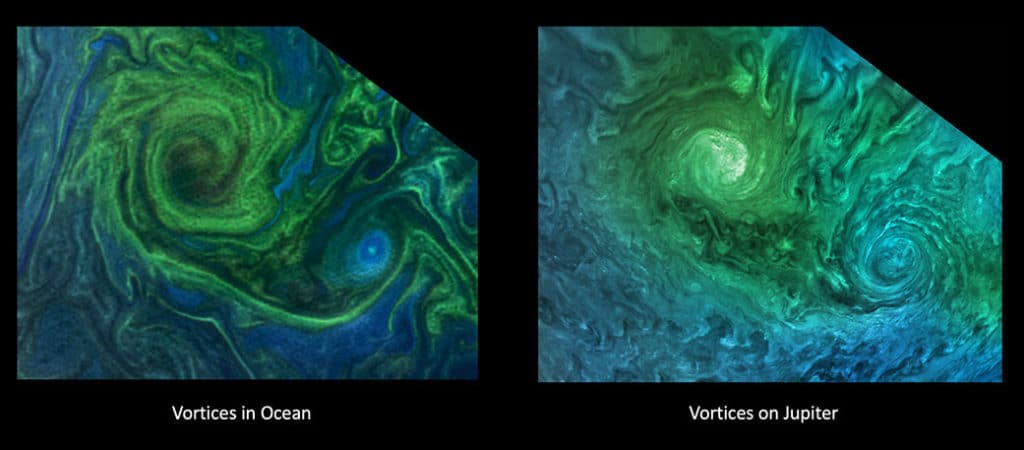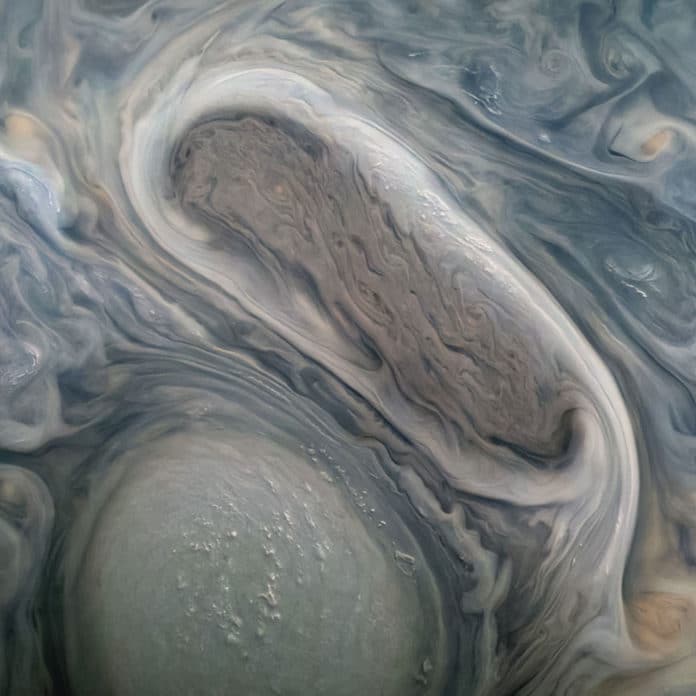NASA‘s Juno spacecraft recorded sounds from a Ganymede flyby of the Jovian moon Ganymede on June 7, 2021. This 50-second soundtrack makes you feel like you were riding along as Juno sails past Ganymede.
The soundtrack was obtained from data collected during the mission’s close flyby. The Waves instrument on Juno tunes in to electric and magnetic radio waves produced in Jupiter‘s magnetosphere collected the data on those emissions.
Juno Principal Investigator Scott Bolton of the Southwest Research Institute in San Antonio said, “If you listen closely, you can hear the abrupt change to higher frequencies around the midpoint of the recording, which represents entry into a different region in Ganymede’s magnetosphere.”
William Kurth of the University of Iowa in Iowa City, lead co-investigator for the Waves investigation, said, “Detailed analysis and modeling of the Waves data are ongoing. It is possible the change in the frequency shortly after the closest approach is due to passing from the nightside to the dayside of Ganymede.”
Jack Connerney from NASA’s Goddard Space Flight Center in Greenbelt, Maryland, and his team have produced the most detailed map ever obtained of Jupiter’s magnetic field.
They created the map by gathering data from 32 orbits during Juno’s prime mission. This map offers insights into the gas giant’s mysterious Great Blue Spot, a magnetic anomaly at the planet’s equator.
The data obtained indicate that a change in the gas giant’s magnetic field has occurred during the spacecraft’s five years in orbit. The team also found that the Great Blue Spot is drifting eastward at a speed of about 2 inches (4 centimeters) per second relative to the rest of Jupiter’s interior, lapping the planet in about 350 years.
The map shows that this blue spot is getting apart due to Jupiter’s zonal winds. This means that the zonal winds measured on the planet’s surface reach deep into the planet’s interior.
Through this map, scientists found that the dynamo action – the mechanism by which a celestial body generates a magnetic field – in Jupiter’s interior occurs in metallic hydrogen beneath a layer expressing “helium rain.”

Lia Siegelman, a physical oceanographer and postdoctoral fellow at Scripps Institution of Oceanography at the University of California, San Diego, said, “When I saw the richness of the turbulence around the Jovian cyclones, with all the filaments and smaller eddies, it reminded me of the turbulence you see in the ocean around eddies. These are especially evident in high-resolution satellite images of vortices in Earth’s oceans that are revealed by plankton blooms that act as tracers of the flow.”
Using a simplified model of Jupiter’s pole, the team found that the geometric vertices spontaneously emerge and survive forever. This means that the basic geometrical configuration of the planet allows these intriguing structures to form.
Heidi Becker, lead co-investigator of Juno’s Stellar Reference Unit instrument at NASA’s Jet Propulsion Laboratory in Pasadena, said, “It is breathtaking that we can gaze at these familiar constellations from a spacecraft a half-billion miles away. But everything looks pretty much the same as when we appreciate them from our backyards here on Earth. It’s an awe-inspiring reminder of how small we are and how much there is left to explore.”
